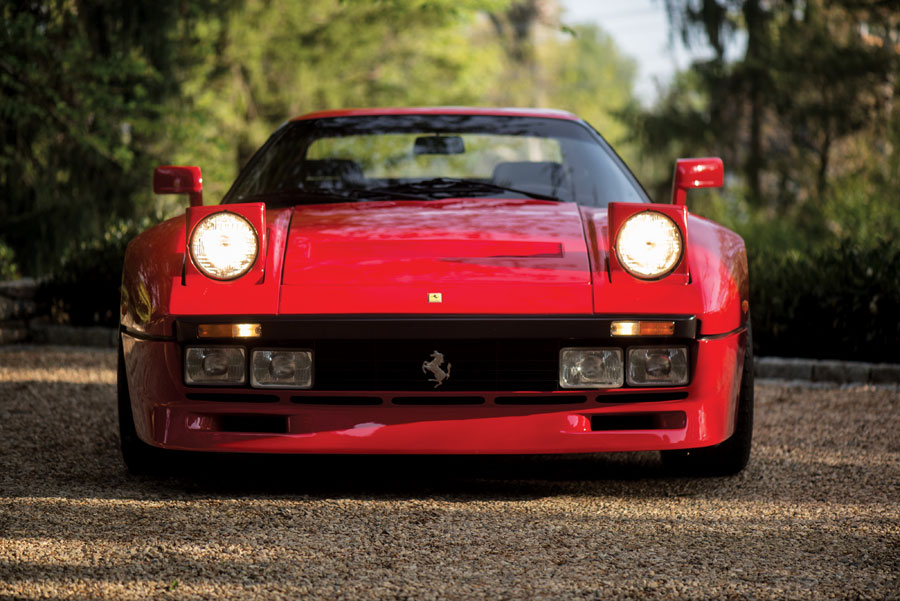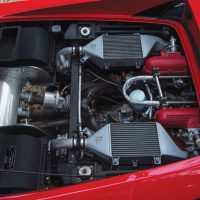- One of only 272 produced
- Three owners from new; driven 23,555 original kilometers
- Equipped with factory air conditioning and power windows
- Includes original owner’s manuals, toolkit, jack and spare key
SCM Analysis
Detailing
| Vehicle: | 1985 Ferrari 288 GTO |
| Years Produced: | 1984–86 |
| Number Produced: | 272 |
| Original List Price: | $83,400 |
| SCM Valuation: | $2,934,000 |
| Tune Up Cost: | $3,500 |
| Distributor Caps: | $300 each. Two required |
| Chassis Number Location: | Stamped on the upper frame in the engine compartment |
| Engine Number Location: | Stamped on the top of the engine block near the front |
| Club Info: | Ferrari Owners Club, Ferrari Club of America |
| Website: | http://www.ferrariownersclub.org |
| Alternatives: | 1987–92 Ferrari F40, 1986–88 Porsche 959, 1991–93 Jaguar XJ 220 |
| Investment Grade: | B |
This car, Lot 279, sold for $2,310,000, including buyer’s fees, during RM Sotheby’s “Driving into Summer” online auction from May 21 to 29, 2020.
Faster than a speeding bullet. More powerful that a locomotive. Jet-fighter acceleration.
That’s the experience I expected the first time I drove a Ferrari. My high-school Mustang was good for a quarter block of smoking rubber. Shouldn’t a car built by a legendary race-car manufacturer — and that costs as much as a house — put that to shame? I expected acceleration that pinned my cheeks back, a bit too much gas breaking the rear tires loose, and a racing suspension that would rattle my fillings out.
When I finally got my 15 minutes alone in a 308 GTS, I found my expectations were quite a bit off reality. The Ferrari I drove was red but didn’t wear a cape.
My first extended trip in a Ferrari woke me to the real essence of the brand. While I was expecting 427-Corvette performance, that’s not what a Ferrari is about. The ability to make a car go fast without it feeling fast is what separates a Ferrari from the pack.
Ferraris start to feel good when other cars begin to feel scary.
Going fast requires good traction. Great suspensions keep the tires on the ground while giving a comfortable ride. Smoking tires was something you couldn’t do with a Ferrari — or so I thought.
One hot Ferrari
I usually avoid a boring dissertation on specifications, but hang in there, I’ve got a point. Going into 1984, Ferrari’s top-of-the-line model was the 12-cylinder 512 Boxer. Their mainstream model was the 8-cylinder 308 Quattrovalvole. Ferrari claimed the Boxer was the fastest car in the world. The 308 made no pretense of challenging the Boxer but was world-class in its own way. The Boxer’s 340-hp engine was roughly 72 hp per liter. The Boxer weighed about 3,100 pounds, for around 0.1 hp per pound. Ferrari claimed the Boxer would hit 62 mph in 5.2 seconds.
Ferrari rated their U.S. model 308 GTB Quattrovalvole at 2,900 pounds and 240 hp. That is about 80 hp per liter and 0.08 hp per pound. Sixty-two mph came in about 6.7 seconds.
In 1984, Ferrari introduced the 288 GTO — or just GTO, as Ferrari called it. The GTO was a game changer. It was conceived to compete in the World Rally Championship against the outrageous 600-hp Killer B Group B rally cars. Unfortunately for Ferrari, the class was canceled after the Killer Bs were deemed too deadly for the series. Fortunately for enthusiasts, that meant that more GTOs would be available for private ownership.
The GTO’s twin-turbocharged 2.8-liter V8 was rated at 400 hp. That is an astounding 140 hp per liter, nearly twice the ratio of the Boxer. Factoring the horsepower to the weight, the GTO had nearly 50% more horsepower per pound than the 512 Boxer. The 308 doesn’t even make the comparison.
Now we have a Superman
Older turbo systems were switch off/switch on. When the boost came on, the horsepower violently changed. Within a few rpm, the horsepower could double, and that’s where it gets fun. Sixty-two mph comes to the GTO in 4.9 seconds. That was a serious number at the time, but is misleading to the experience. There is an initial lull as the boost comes on — then you’re at redline. Shift and keep it on boost for an adventure you’re never going to forget.
Even the best suspension can be overpowered, and the GTO proves the point. Tires easily spin on acceleration. Even at speed, tires will chirp under heavy throttle when road conditions are less than ideal. Today, traction control will not allow tires to spin — but in a GTO, coming on boost is quite a thrill.
Performance dominates the GTO’s appeal, but it would still be a hit even if it did not move. Leonardo Fioravanti, Pininfarina’s design chief at the time, is credited for the styling. He used a 308 GTB as his inspiration, and from it produced a silhouette certain to live on as one of the most beautiful of all time.
Fioravanti honored Ferrari’s original 250 GTO with a gorgeous Kamm tail and air vents in the lower rear quarter panels. He made room for big Goodyear tires by flaring the fenders at the wheel openings. A new front spoiler, outrageous outside mirrors and three-piece wheels are just a couple of the GTO’s distinctive features. Ninety percent of the GTO’s content is unique to the car, an admirable feat for a model with just 272 examples.
Our subject supercar
Our 288 GTO is a world traveler. It was sold new to a German-based collector who picked it up at the Ferrari factory. He did not even make it home before the car was stolen out of a hotel parking garage in the south of France. A detective working for his insurance company tracked the car to an Arizona dealer, where it had landed after temporary stays in both France and Italy.
Once back in Germany, the 288 GTO took a place of honor next to the owner’s 250 GTO. The theft did not deter the owner from enjoying the car. He put on more than half of the car’s 23,555 kilometers (14,636 miles).
The next stop was back to the United States, where it landed in 2001 to join the second of the car’s lucky three owners.
Our subject GTO was the second-highest sale of RM Sotheby’s “Driving into Summer” online auction.
RM Sotheby’s $2,200,000–$2,400,000 estimate seemed low for a model that has sold as high as $3,900,000 just a few years back, but the auction house was proved to be right. The $2,310,000 sale could not have been closer to the estimate.
Buyers of 288 GTOs are particularly picky. They often have a collection of ultra-low-mileage supercars. They will pay up for a low-mile 288 GTO — and show no love for driven examples. This car had an excellent provenance, all the jewelry and no issues with the cosmetics or mechanicals. Unfortunately 14,636 miles on the odometer is too many to make collector status, which was reflected in the sale price.
As much as I want to declare the sale a big win for the buyer, it probably was not.
When you can afford $2,000,000 for a car, you can probably afford $3,000,000. This car wouldn’t make the radar of the heavy hitters who would fight it out for a trophy example. That’s too bad, because there will be little penalty for putting some miles on this car, and that’s what a 288 GTO is really about. ♦
(Introductory description courtesy of RM Sotheby’s.)




